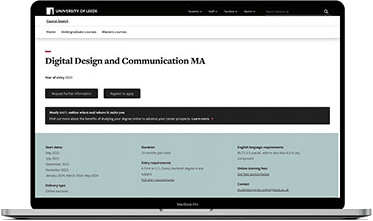What is Human-Centred Design?
Digital Design and Communication
Human centred design is an important yet complex area of the digital design world.
In this blog, we explore its importance and some real-world examples of it in action.
Learn more about our Digital Design and Communication courseA definition of human-centered design
Put simply, human centred design refers to an approach to creative problem solving where designed products are tailored specifically to the needs of a target audience. These can be any physical (3D) or digital (2D) products.
It may sound straightforward, however, the process includes a few steps to achieve this. It starts with a deep empathy of potential users and understanding customers’ needs, expectations and motivations in using products, services or systems backed by profound research. This is the most important step as putting the users at the heart of the design process is fundamental.
Following this, ideas are generated considering users’ needs and products are shaped accordingly. Designers must carry out this work while continuing to evolve offerings to meet changing behaviours and demands.
Why is human centred design important?
Human centred design is important in benefitting both users and the businesses whose digital products are accessed by them.
By leveraging customer insight, businesses can make digital designs more user-friendly and efficient, increasing interaction and engagement with their product and removing certain barriers (for example, accessibility issues). In most cases, this is likely to lead to an increase in sales and customer satisfaction.
The key principles of human centred design
As a digital designer, it’s important to keep these three key principles in mind:
1. Consider your target audience
Digging into who your target audience is, is an essential first step to success. You’ll need to know who is using your product, what their characteristics are, when they are engaging and why they are interested.
2. Show deep empathy
Secondly, you’ll need to show empathy with people and examine some of the key challenges they are facing. You’ll need to understand what motivations they have to use your product, which of their needs may be covered by your product, what barriers they are facing with your digital product and what is stopping them from interacting or purchasing what you have to offer.
3. Start ‘designing human’
Once you’ve understood your target audience and shown empathy with people, you’ll then need to start taking a human centred approach. This is about making your product fit for purpose. Examine what you know about your customers and the challenges they face before leveraging that information in your design processes to tailor your product offering. By putting your target audience’s needs at the heart of your digital product, you and your customers will experience a mutual benefit.
Real-world examples of human centred design
The University of Leeds is engaged in lots of different research projects, which form part of the Digital Design and Communication online Masters. Here are some of the top real-world examples underway at the University.

Investigating driving behaviour
The University of Leeds driving simulator is one of the most technically advanced in the world. The virtual reality dome uses a human centred design approach to research new technologies before they are fully implemented in vehicles. By using digital design to develop realistic and repeatable scenarios, researchers are using driving data, psychophysiological metrics and more to improve driver safety and develop autonomous vehicles.

Measuring pedestrian interaction
The Highly Immersive Kinematic Experimental Research (HIKER) pedestrian lab is the largest 4K resolution pedestrian simulation environment in the world, allowing users to interact with a variety of urban environments using VR equipment. One way this research project uses human centred design is in its exploration of pedestrians’ interaction with vehicles in life-threatening situations. From this digital research, warning systems, road crossings and intersection configurations can be optimised to improve safety.

Exploring urban planning
Virtuocity is another simulation tool used at the University of Leeds making the design of urban planning more human-centric. The digitally designed platform prototypes solutions to challenges in urban mobility and dynamics before they are physically rolled out. The research is driving human centred design in projects such as Smart Motorways and other transport systems, improving safety, accuracy and uncovering new technological opportunities.
Top human centred design books and resources
At the Leeds School of Design, we recommend the following books and resources if you are interested in further reading:
Study Digital Design and Communication online
If you are looking to understand the key principles of the digital design world, then our online Digital Design and Communication Masters / Postgraduate Certificate is the right course for you.
In the Human Centred Design module, you’ll focus on how to understand the needs of a target audience and which design processes and products can meet these. You’ll collect and analyse data to comprehend what works best for them before applying user testing to evaluate and deliver real-world design concepts and solutions. This is just one of many specialist modules you’ll undertake in our Masters to Ignite Your Career as a Digital Design Leader.
Delivered fully online by the University of Leeds, the course is designed to support your career ambitions in the digital design sector and other creative industries. If you see yourself in a Digital Design Manager role, driving innovation and solving complex communication problems, this Masters is ideal for you.

Did you enjoy this blog? Here’s some related digital design and communication content you may be interested in:

Want to learn more about our online Digital Design and Communication course?
Check out the course content and how to apply.

